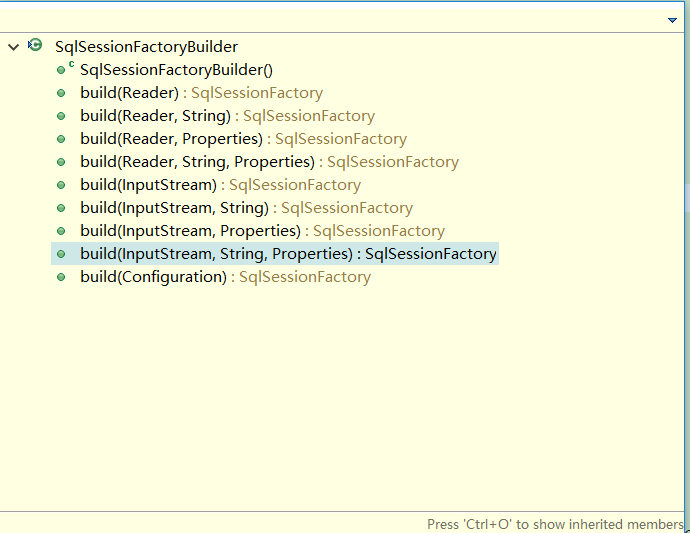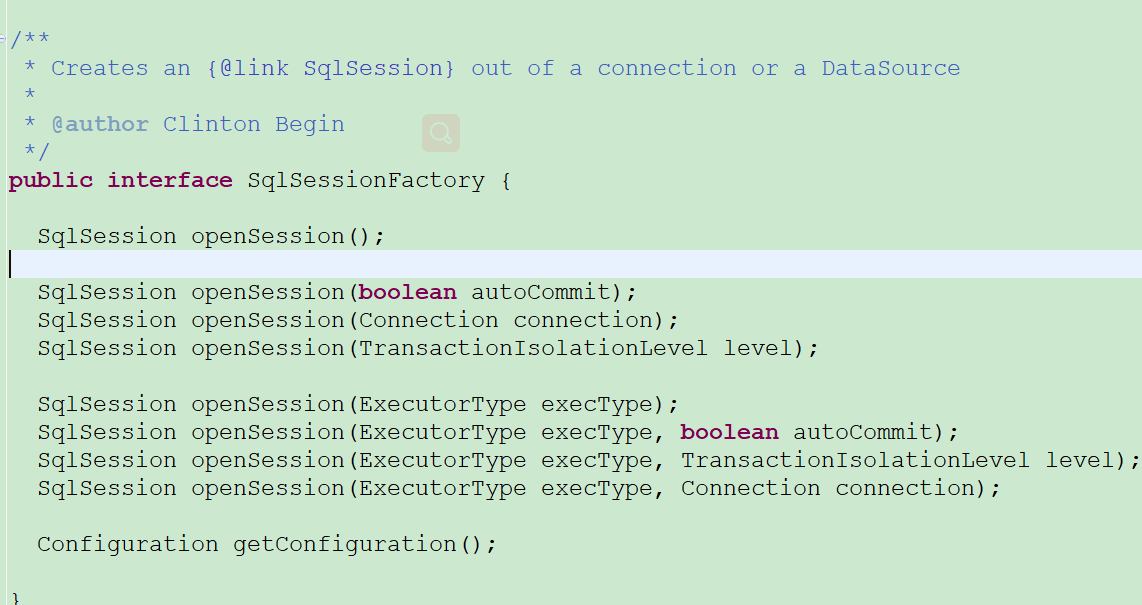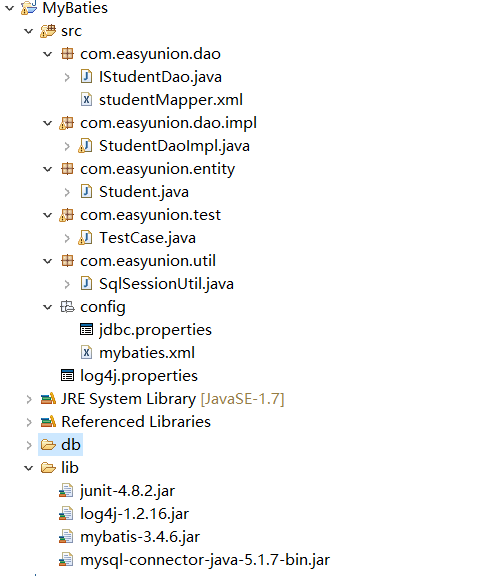1.什么是mybaties
mybaties 是一个持久层框架,也可以称为ORM的一种实现( Object relational mapping),支持普通sql,存储过程和高级映射。
2.入门
2.1SqlSession实例
每个Mybaties程序都以一个SqlSession对象的实例为核心。那么什么是SqlSession,他到底有什么用?我在源码的注释里面看到了这么一句话:“The primary Java interface for working with MyBatis.
, Through this interface you can execute commands, get mappers and manage transactions.(java使用mybaties的主要接口,通过这个接口你可以执行命令,获取映射和管理事务)”。看到这个我觉得这 个sqlsession对象应该是可以满足我们第一个demo的crud了。既然他是一个接口 ,那我们使用的话一定是使用他的实现类,该接口下有两个实现类(DefaultSqlSession和SqlSessionManager).本文我们先 使用DefaultSqlSession。
2.2 SqlSessionFactoryBuilder
这个类的说明很简单 Builds {@link SqlSession} instances(创建SqlSession实例).ok,我们就通过这个类来获取一下sqlsession实例。
我们发现这个类有多个重载的build方法,既然是获取操作数据库的对象,那么连接数据库的四要素肯定是要以某种形式作为build方法的参数传入的,但返回的并不是SqlSession对象,而是一个SqlSessionFactory,那我们在看一下这个SqlSessionFactory是用来做什么的,其实熟悉设计模式的人看到这个方法就知道他是干啥的了。 我们还是跟一下源码吧。

Creates an {@link SqlSession} out of a connection or a DataSource 从连接或者数据源中获取一个sqlsession,ok 我们现在找到了获取sqlsession的方法了,他也提供了许多重载的方法,我们先使用第一个吧。
2.3 SqlSessionFactoryBuilder中build方法的参数之mabaties主配置文件(demo中命名为mybaties.xml)
<?xml version="1.0" encoding="UTF-8"?> <!DOCTYPE configuration PUBLIC "-//mybatis.org//DTD Config 3.0//EN" "http://mybatis.org/dtd/mybatis-3-config.dtd"> <configuration> <properties resource="config/jdbc.properties"><!-- 加载jdbc属性文件--> </properties> <typeAliases> <package name="com.easyunion.entity" /><!-- 以包的形式定义别名,别名即为简单类名--> </typeAliases> <environments default="mysqlEM"> <environment id="mysqlEM"> <!-- <transactionManager type="JDBC">jdbc的事务管理</transactionManager> --> <transactionManager type="JDBC"></transactionManager> <dataSource type="POOLED"> <property name="driver" value="${jdbc.driverClass}" /> <property name="url" value="${jdbc.url}" /> <property name="username" value="${jdbc.username}" /> <property name="password" value="${jdbc.password}" /> </dataSource> </environment> </environments> <!-- 注册映射文件 --> <mappers> <mapper resource="com/easyunion/dao/studentMapper.xml" /> </mappers> </configuration>
当然 构建SqlSessionFactory的方式不仅限于xml文件,也可以从JavaConfig中获取,这里我们使用xml。本文的目的是先让第一个mybaties demo跑起来。主配置文件和mapper.xml文件就放在后面的文章中进行详细的解释。因为有太多的细节,我认为单独写一篇文章是有必要的。
3.第一个mybaties Demo
3.1工程目录

package com.easyunion.entity; //学生pojo public class Student { private Integer id; private String name; private Integer age; private double score; public Student() { } public Student(String name, Integer age, double score) { this.name = name; this.age = age; this.score = score; } @Override public String toString() { return "Student [id=" + id + ", name=" + name + ", age=" + age + "score" + score + "]"; } public Integer getId() { return id; } public void setId(Integer id) { this.id = id; } public String getName() { return name; } public void setName(String name) { this.name = name; } public Integer getAge() { return age; } public void setAge(Integer age) { this.age = age; } public double getScore() { return score; } public void setScore(double score) { this.score = score; } }
package com.easyunion.dao; import com.easyunion.entity.Student; public interface IStudentDao { //添加学生 void insertStudent(Student student); }
StudentMapper.xml
<?xml version="1.0" encoding="UTF-8"?> <!DOCTYPE mapper PUBLIC "-//mybatis.org//DTD Mapper 3.0//EN" "http://mybatis.org/dtd/mybatis-3-mapper.dtd"> <mapper namespace="student"> <insert id="insertStudent"> INSERT INTO student(name,age,score) values(#{name},#{age},#{score}) </insert> </mapper>
dao接口的实现类
package com.easyunion.dao.impl;
import java.io.IOException;
import java.io.InputStream;
import org.apache.ibatis.io.Resources;
import org.apache.ibatis.session.SqlSession;
import org.apache.ibatis.session.SqlSessionFactory;
import org.apache.ibatis.session.SqlSessionFactoryBuilder;
import com.easyunion.dao.IStudentDao;
import com.easyunion.entity.Student;
import com.easyunion.util.SqlSessionUtil;
public class StudentDaoImpl implements IStudentDao {
SqlSession sqlSession = null;
@Override
public void insertStudent(Student student) {
sqlSession = SqlSessionUtil.getSqlSession("config/mybaties.xml");
sqlSession.insert("insertStudent", student);
sqlSession.commit();
SqlSessionUtil.colseSqlSession(sqlSession);
}
}
获取sqlsession的工具类
package com.easyunion.util; import java.io.IOException; import org.apache.ibatis.io.Resources; import org.apache.ibatis.session.SqlSession; import org.apache.ibatis.session.SqlSessionFactory; import org.apache.ibatis.session.SqlSessionFactoryBuilder; /** * 工具类 * @author lwh * */ public class SqlSessionUtil { private static SqlSessionFactory factory; /** * 获取Mybaties的sqlSession对象 * * @param xmlPath * mybaties主要配置文件的位置 * @throws IOException * */ public static SqlSession getSqlSession(String xmlPath) { SqlSession sqlSession = null; try { if (factory == null) { factory = new SqlSessionFactoryBuilder().build(Resources .getResourceAsStream(xmlPath)); } sqlSession = factory.openSession(); return sqlSession; } catch (IOException e) { e.printStackTrace(); } return sqlSession; } /** * 关闭sqlSession * * @param sqlSession */ public static void colseSqlSession(SqlSession sqlSession) { if (sqlSession != null) { sqlSession.close(); } } }
jdbc.properties
jdbc.driverClass = com.mysql.jdbc.Driver jdbc.url =jdbc:mysql://127.0.0.1:3306/test jdbc.username= root jdbc.password =123456
测试类
package com.easyunion.test; import org.junit.Before; import org.junit.Test; import com.easyunion.dao.IStudentDao; import com.easyunion.dao.impl.StudentDaoImpl; import com.easyunion.entity.Student; public class TestCase { private IStudentDao stuDao; @Before public void init() { stuDao = new StudentDaoImpl(); } @Test public void testInsert() { Student st = new Student("mybaties", 7, 90); stuDao.insertStudent(st); } @Test public void test() { } }